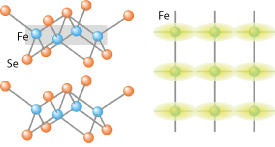

04/27/2015

© 2015 Takashi Takahashi
AIMR researchers have taken a vital step toward understanding the mechanism of superconductivity in iron selenide (FeSe) by analyzing the material using photoemission spectroscopy. Their findings support the conjecture that the material’s superconductivity is linked to an unconventional state known as the nematic phase, which is characterized by a roughly parallel alignment of atoms.
The discovery of iron-based superconductors in 2006 came as a complete surprise because iron’s ferromagnetism had been expected to prevent superconductivity. Since the discovery, scientists have been scrambling to explain the mechanism that gives rise to the superconductivity of these iron-based materials.
Iron selenide has been attracting special interest because it has the simplest crystal structure of iron-based superconductors (see left side of image) and also because one-atom-thick films of FeSe have been found to be superconductive up to temperatures close to the boiling point of liquid nitrogen at 77 kelvin. However, its electronic structure has not been studied in detail because of the difficulty of producing high-quality crystals.
Taking advantage of recent advances in FeSe crystal growth, researchers at Tohoku University led by Takashi Takahashi of the AIMR have now used angle-resolved photoemission spectroscopy to explore the electrical structure of single crystals of FeSe as a function of temperature1. Their findings suggest that the nematic phase plays a critical role in the superconductivity of FeSe.
The measurements revealed a sizeable splitting in the electronic band structure of the material that is present at low temperatures and persists beyond 90 kelvin — the temperature at which the structure of FeSe changes. Since bulk FeSe lacks long-range magnetic order, this result demonstrates that long-range magnetic order is not essential for inducing large band splitting. Instead, the researchers strongly suspect that the splitting is caused by electronically driven nematic states ― a form of electronic order that breaks the rotational symmetry of the lattice while leaving its translational symmetry intact (see right side of image).
“The present finding provides a key for understanding the unconventional superconductivity in FeSe,” says Takahashi, “and also for elucidating the origin of nematicity in iron-based superconductors.”
The researchers intend to explore the material further. “Our future goals are to elucidate how superconductivity evolves from the bulk material to a film,” explains Takahashi. “We will also try to increase the superconducting transition temperature — hopefully, to much higher than the boiling point of liquid nitrogen — by tuning the electronic states by adjusting the structures of devices made from multiple materials.”
Nakayama, K., Miyata, Y., Phan, G. N., Sato, T., Tanabe, Y., Urata, T., Tanigaki, K. & Takahashi, T. Reconstruction of band structure induced by electronic nematicity in an FeSe superconductor. Physical Review Letters 113, 237001 (2014). | article
This research highlight has been approved by the authors of the original article and all information and data contained within has been provided by said authors.